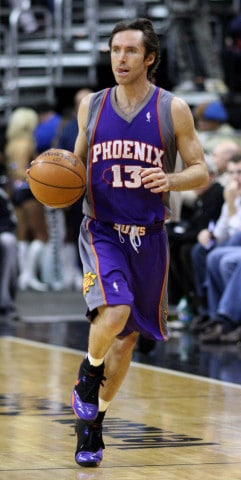KADE GATES
On March 21, Canada’s greatest basketball player and the man who inspired a nation to pick up a ball retired. However, the question remains: what was Steve Nash’s legacy?
Nash was a freshman point guard at Santa Clara University who lead the 15th ranked Broncos to a first round upset of the number two seed University of Arizona Wildcats in the March Madness tournament. As a rookie, he was booed at the NBA draft by Phoenix Suns fans when he was selected 15th overall — and then proceeded to become their all-time leading assist man.
He led the famous “seven seconds or less” Phoenix Suns offence that set a record for points per game in a season alongside teammates Amar’e Stoudemire and Shawn Marion. Nash was also a two-time MVP, an eight-time All-Star and one of the greatest point guards in NBA history.
To me, Nash will be remembered for his heart, grit and determination. Here are two of the greatest examples of Captain Canada’s displays of heart.
At the 2000 Sydney Olympics, the Canadians came in featuring a roster with a grand total of two NBA players, Todd MacCulloch and Nash. Not much was expected of the scrappy Canadians until Nash hit the floor. He carved up the opposition from the opening tip of the tournament. Nash averaged nearly 14 points, seven assists and four rebounds a game while leading the Canadians to first in their pool.
The hallmark game came against the Yugoslavians, led by NBA star Peja Stojaković. Nash proceeded to absolutely torch the Yugoslavians for 26 points, eight rebounds and eight assists, while only turning the ball over once in the process and locking up first place for Canada.
It wasn’t meant to be for Team Canada as they were dispatched in the quarter-finals at the hands of France. Nash was in tears while being helped off the floor by teammates, clearly upset that the Olympic journey was over.
This was the only chance Nash ever had at an Olympic medal; Canada has not returned to an Olympic basketball competition since, but looks primed to do so this coming summer when qualification begins for 2016.
The next example comes in the 2007 NBA Western Conference Semifinals. After taking a knee to the groin courtesy of San Antonio Spur Bruce Bowen and suffering a broken nose during a collision with Tony Parker, Nash led the Suns on a fourth quarter comeback to defeat the Spurs, tying their best-of-seven series at two apiece.
With roughly 20 seconds left in the game and the Suns up three, Robert Horry bodychecked Nash into the announcers table and started a fight on the court. Nash calmly walked up to the free throw line and iced the game.
The next game — without Stoudemire, who was suspended due to a fight in the previous game — Nash led his team with a double-double and nearly stole game five away from the Spurs. The Suns wound up losing the series in six games.
Nash never won an NBA championship and will go down in history as one of the best players ever to not win a title. The class act announced his retirement through an article on The Players’ Tribune, a website where athletes can write articles.
“I will likely never play basketball again. It’s bittersweet. I already miss the game deeply, but I’m also really excited to learn to do something else. This letter is for anyone who’s taken note of my career. At the heart of this letter, I’m speaking to kids everywhere who have no idea what the future holds or how to take charge of their place in it. When I think of my career, I can’t help but think of the kid with his ball, falling in love. That’s still what I identify with and did so throughout my entire story,” Nash wrote.
When Nash picked up a basketball and fell in love with the sport, little did he know that in doing so he would cause millions from an entire nation to fall in love with the sport as well.
Thank you for all you’ve done for the game of basketball, Steve Nash.